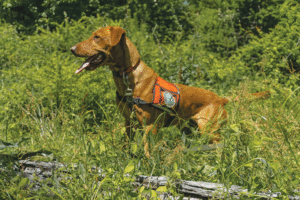
Dia, an energetic American Field Labrador Retriever searches for invasive Scotch Broom plants in New York’s in the Lower Hudson Valley. She’s been in the field on more than 20 surveying trips this year. Across the country, dog noses are becoming detection instruments aimed at protecting animals and habitat. (Photo courtesy Joshua Beese)
Police and the military have long deployed dogs’ enhanced sense of smell to locate people, cadavers, drugs, weapons and explosives.
Health care professionals, too, have brought canine olfactory capabilities into service while sniffing out diseases.
Now, dog noses are becoming detection instruments aimed at protecting animals and habitat. Working Dogs for Conservation headquartered in Bozeman, Montana blazed the trail in adapting earlier training methods from other disciplines to help track and map remote animals, combat poachers and ivory traffickers, and locate invasive critters, fish, insects and plants not readily visible to human eyes and early enough to help eradicate them.
Now, organizations around the country (and the world) are joining the movement.
As for invasive species, WD4C pups Camas, Lily, Seamus and Pepin have been successfully sniffing out Dyer’s Woad, an invasive plant blanketing grassland around Missoula’s Mount Sentinel.
Each “woad” can spawn more than 10,000 seeds, and for 10 years, volunteers searched relentlessly, pulling them up, but they always returned.
After four years of using dogs, the numbers are down by 99.8 percent.
By the time people visually located the woad, the plant had likely already reproduced.
The dogs used scent to detect remnant roots of pulled plants, preventing regrowth.
They also found 500 plants missed by human searchers the first year, but they’d already seeded. The second year, the same plants were located early enough to prevent them from developing seeds.
WD4C has found a formula to successfully identify detection dogs and the process involves casting a wide net in unlikely places.
A unique screening process aimed at hard to place shelter dog populations, those often described as “too much dog,” according to WD4C Executive Director Pete Coppolillo, may now get a second chance at life.
Examples can be seen among the 31 dogs comprising the group’s “pack” pictured on the group’s website.
Tobias was found wandering the streets of Helena, Mont.; Tigre was too active to be a veteran’s service dog; Lily had five different homes in three years; Atlas was blind since birth; Orbee was a misfit Border Collie, bored by herding and returned to the shelter labeled a failed ranch dog.
The dogs’ stories of being too hyperactive begin to sound familiar.
But these very qualities turned out to make them perfect candidates for relentless field work in rustic conditions, their “extreme ball drive” and “toy obsession” providing powerful motivation.
“The toy becomes the paycheck,” Coppolillo added.
Across the country last year, an energetic fox red American Field Labrador Retriever named Dia was “hired” by the New York-New Jersey Trail Conference to ferret out invasive Scotch Broom plants in Bear Mountain and Harriman State Parks in the Lower Hudson Valley, the first permanent program of its kind in the Northeast.
Joshua Beese, a search and rescue dog handler with the New Jersey Task Force and FEMA, located, evaluated and trained Dia, who came from a Wisconsin farm known for breeding hunting dogs.
This year, she’s been in the field on more than 20 surveying trips.
At sites where the Trail Conference’s Invasives Strike Force Human Crew were sure each plant they found had been removed, Dia ended up finding a few more. Dia will soon scent train to identify Slender False Broom in the Finger Lakes region and the Spotted Lantern Fly.
Dia’s energy, enthusiasm, and quickness to learn aren’t the only attributes she brings to the program, according to Beese.
Her friendliness to people, especially kids, makes her a great asset at demonstrations, helping put a friendly furry face on an issue that isn’t exactly “sexy,” he said, adding, “with Dia, we get the best of both worlds.”
Just this year, on Oahu, Kyoko Johnson started the nonprofit Conservation Dogs of Hawaii, which utilizes professional dog/handler teams along with pet/handlers to detect invasive species such as Devil Weed, whose tiny fruits with tender white leaves which attach to animal fur like Velcro.
In July the group co-hosted a Conservation Dog Symposium addressing the practical experience and science behind using detection dogs to promote conservation goals throughout Hawaii, where the idea is slowly gaining ground.
Johnson’s especially pleased that the dogs sniffing for Devil Weed, found near hiking trails, serve as both detectors and citizen science educators, helping raise interest and awareness of the threat posed by invasive species.
Self-described “nosey dog nerd” Laura Holder was hired by Mequon Nature Preserve outside of Milwaukee, Wis., to develop their conservation detection dog program in 2017.
A certified dog trainer and nose work instructor, Holder was not only impressed by what the dogs could do to help the environment, but by how much work needing doing.
Later that year, she co-founded Midwest Conservation Dogs, providing the group with an executive director, canine handler, animal trainer, and behavioral expert all in one.
Her personal dog, 2-year-old yellow Labrador Retriever K-9 Ernie, is a dedicated field work enthusiast, currently trained to sniff out invasive wild parsnip, but also brings his A game to educational programs, with his own neighborhood fan club.
Among the group’s latest projects is the Pollinator Program, which employs scent trained dogs to help Beekeepers identify colonies infected by American Foulbrood, a fatal bacterial disease.




